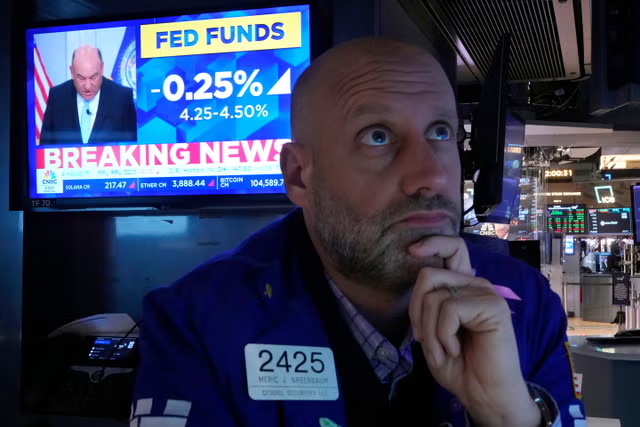
Market Shock: Stock Futures Hold Steady Amid Fed’s Sobering Rate Forecast
Stock futures experienced minimal changes Wednesday night as investors grappled with a sobering outlook for financial markets. The session saw heightened volatility following the Federal Reserve’s revised interest rate projections for the upcoming year.
Futures tied to the Dow Jones Industrial Average rose 62 points, or 0.15%, while S&P 500 futures hovered just above flat. Nasdaq 100 futures edged down by 0.18%.
Earlier on Wednesday, stocks plunged after the Federal Reserve dampened the bullish market sentiment by signaling that it would likely reduce interest rates only twice next year. This marked a significant shift from the four cuts projected in its September forecast. The central bank lowered its benchmark overnight borrowing rate by a quarter percentage point to a target range of 4.25% to 4.5%. The uncertainty now lies in the Fed’s actions for 2025 in Stock.
Stretched positioning and sentiment left stocks vulnerable to a selloff,” remarked Jeff Buchbinder, chief equity strategist at LPL Financial, in response to the market’s downturn. “The significant jump in inflation expectations and the accompanying bond selloff provided a convenient trigger. When support from the tech sector evaporated, no other groups were positioned to fill the gap.
Federal Reserve Chair Jerome Powell offered little reassurance to investors during his post-meeting press conference. “We’re at 4.3% — a meaningfully restrictive level that we believe is well-calibrated to continue progress on inflation while maintaining a strong labor market,” Powell stated. He added that recent rate cuts have allowed the central bank to adopt a more cautious approach as they consider further adjustments.
Heading into Wednesday’s rate decision, Wall Street had largely anticipated the Fed’s more aggressive stance in reducing borrowing costs. Interest rates influence everything from corporate capital-raising expenses to consumer costs for home and car purchases. However, the Fed’s revised outlook triggered a sharp market selloff.
The Dow Jones Industrial Average dropped 1,123.03 points, or 2.58%, to close at 42,326.87. This marked the Dow’s 10th consecutive decline, its longest losing streak since 1974, and set the index on track for its worst weekly performance since March 2023. The S&P 500 fell 2.95% to 5,872.16, while the Nasdaq Composite lost 3.56%, ending at 19,392.69. Losses in the tech-heavy Nasdaq accelerated in the latter part of the session. The Dow and S&P 500 both recorded their largest one-day drops since August, a period marked by market turbulence due to the unwinding of the yen carry trade.
Treasury yields surged in response to the Fed’s cautious outlook, adding further pressure on equities. The 10-year Treasury yield climbed over 13 basis points to surpass 4.50%.
The Cboe Volatility Index (VIX), often called Wall Street’s “fear gauge, spiked, reflecting heightened investor uncertainty about the future trajectory of interest rates.
In after-hours trading, Micron Technology shares plummeted approximately 13% after the company issued weaker-than-expected guidance for the second quarter.
European and Asian Markets React
European markets opened lower on Thursday, with the pan-European Stoxx 600 index falling 1.26%. All sectors began the day in negative territory. Germany’s DAX slipped 1.07%, France’s CAC 40 dropped 1.29%, and the U.K.’s FTSE 100 declined by 1.17%.
In Asia, markets also tumbled following the Fed’s dovish pivot, which triggered a broader selloff. Japan’s Nikkei 225 fell 0.69% to close at 38,813.58, while the Topix index declined 0.22%, finishing at 2,713.83. South Korea’s Kospi index dropped 1.95%, closing at 2,435.93, and the Kosdaq index fell 1.89% to 684.36. The South Korean won hovered near its weakest level since March 2009, trading at 1,452.33 against the U.S. dollar.
Hong Kong’s Hang Seng index declined 0.33% in late trading, while mainland China’s CSI 300 index edged up slightly to close at 3,945.46.
Impact on Cryptocurrency Markets
The Fed’s policy shift has implications for the Stock sector. Chris Rhine, portfolio manager for Galaxy’s actively managed SPDR Galaxy ETFs, noted that while cryptocurrencies faced a short-term selloff alongside equities, the long-term outlook remains positive. “The shift supports the cryptocurrency sector, traditionally viewed as a hedge against inflation and monetary debasement,” Rhine explained. Bitcoin fell over 5% to $100,953.25, while the broader crypto market lost more than 7%.
As markets adjust to the Fed’s outlook, investors will continue to weigh the implications for various asset classes and the global economy.
https://mworldnews.com/wp-admin/post.php?post=897&action=edit